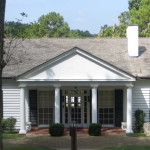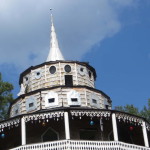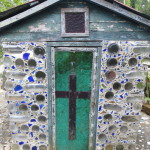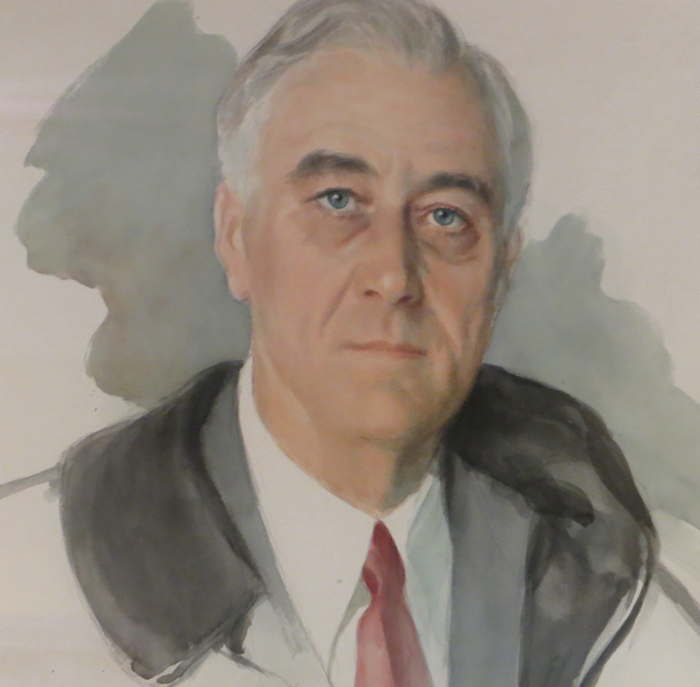Our visit to St. EOM’s Pasaquan was by car, and we had the opportunity to take a brief but fascinating tour through some of the sights in this lovely part of the deep South.
We arrived from Alabama, coming east through Columbus, Georgia, and passing by Fort Benning before arriving at Buena Vista (locally pronounced “BYOO-nah vista”) itself — the town closest to the Pasaquan site. Buena Vista features a central square where St. EOM used to buy his concrete and paints at a hardware store that is now occupied by Buena Vista Projects.

We enjoyed extraordinarily pleasant accommodations at the Sign of the Dove, whose proprietor, Walker Williams, has been a welcoming host to the Kohler Foundation Pasaquan conservation project since its onset. The spacious and generously appointed home is head-and-shoulders above the average B&B or airbnb because of the attention to detail and the professional-level kitchen (it was a gourmet restaurant and dining club in a former incarnation).
A block away we ate at Annie D’s with “the best fried chicken in town,” which is probably a major understatement — it would be hard to imagine better fried chicken no matter how far you are from downtown Buena Vista.
Within a half-hour of Buena Vista is Plains, Georgia, where President Jimmy Carter still teaches Sunday school and has his own national historic site, and the Andersonville National Historic Site, comprised of three main components: the National Prisoner of War Museum, the historic Civil War prison site and Andersonville National Cemetery.
Heading north

Up the road from Buena Vista near Warm Springs, Georgia, we found the therapeutic pools that Franklin Delano Roosevelt enjoyed as relief from his polio, having learned of their existence from the documentary about the Roosevelts by Ken Burns, recently broadcast on PBS.

Just outside of town stands FDR’s Little White House, with an attractive museum and handsome walkable grounds. At the back of the site stands the namesake Little White House, a modest cabin that was built for FDR soon before he became president, but was used far less frequently than originally intended due to the national demands of the Great Depression and World War Two. FDR traveled here when he was able to take a break from his leadership responsibilities to relax. Yet it was at his Little White House that he posed for a portrait that was never finished.
On April 12, 1945, Elizabeth A. Shoumatoff, FDR’s portraitist began the painting while FDR pored over documents and laughed with his staff and guests. She felt his eyes seemed as if they were focused on something far away, and she lured his gaze from the desk by asking questions about stamps in an effort to paint his eyes.

As the butler prepared the table for lunch, FDR prophetically said to Elizabeth, “We have fifteen more minutes to work.” Soon after, he suddenly “…raised his right hand and passed it over his forehead several times, without emitting a sound, his head bending slightly forward.”
FDR was gone.
I am glad that I lived my long life in a world
where there were spiritual values, beauty, and dignity.
— Elizabeth A. Shoumatoff, FDR’s portraitist
Farther up the road

Three hours north of Buena Vista is Summerville, Georgia, the former home of legendary visionary artist Howard Finster where he built his famous Paradise Garden.
Like St. EOM’s Pasaquan, Finster’s garden is a several-acre art environment of his own design and making. The site offers a stark contrast to Pasaquan for two main reasons: religiosity and aesthetics. Finster was a Baptist minister who claimed to be inspired by God to spread the gospel through his tens of thousands of pieces of art. St. EOM was an autodidact who consumed and reinterpreted imagery from many foreign and imaginary cultures without a strict religious agenda. Finster’s innovations often involved dense assemblages of junk, are all over the map stylistically, and became for many the first examples what has come to be known as “outsider” art. St. EOM’s style, on the other hand, is much more internally consistent and fully realized as a unified aesthetic vocabulary.

For me, the creative output of St. EOM offers far greater appeal — the uniformity and vividness of St. EOM’s Pasaquoyan vision outweighs the admitted charms of Finster’s work. Paradise Garden has been lovingly and appropriately maintained and remains an important attraction in western Georgia. I am convinced that Pasaquan will become equally attractive as a backroads attraction, and ultimately a more significant contribution to the permanent legacy of American visionary artists.
UPDATE July 2018: Now there is a self-guided tour of the region that you can access at Visionary Odyssey.

Leave a Reply